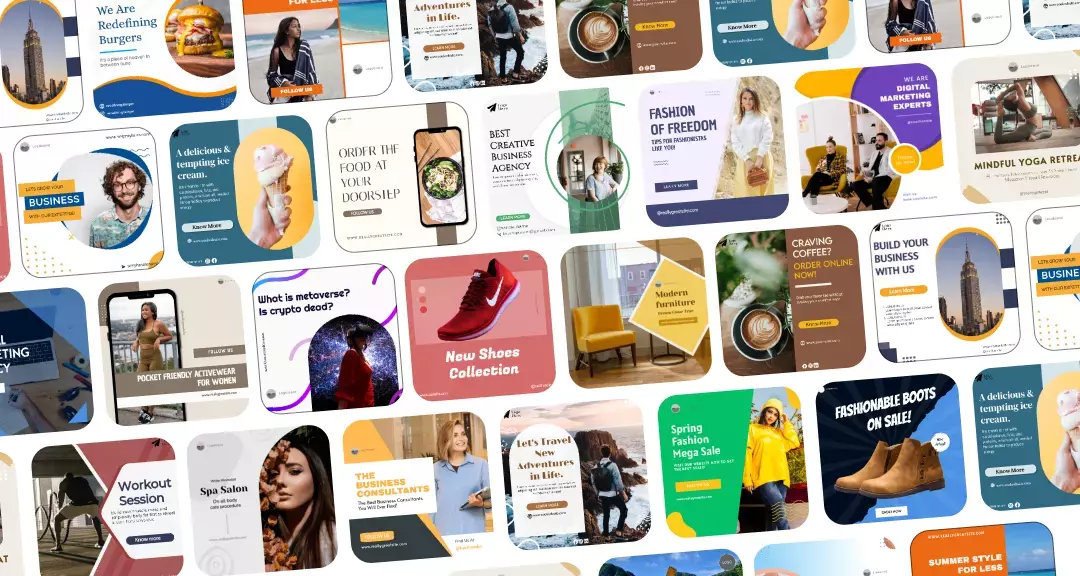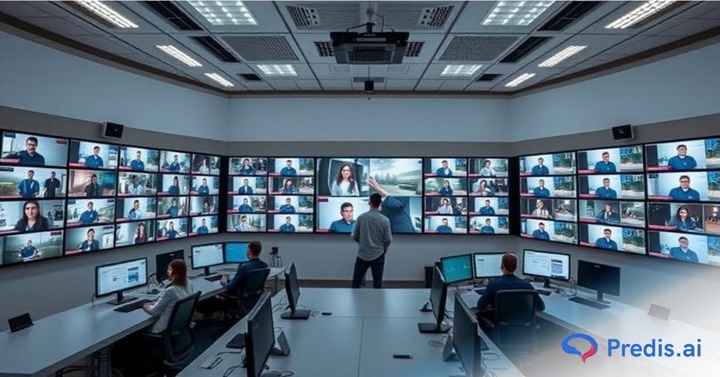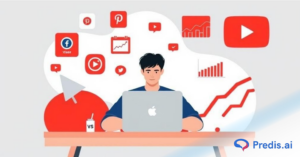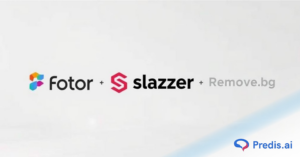Whether it is kicking back after a long day or spending our leisure time at home, the first thing our hands reach for is some video content. This may be a Netflix show or something as regular as an Instagram reel. Therefore, it is not surprising that the average person spends 19 hours of video content every week. With this much video content in circulation, it is essential to have an entity that moderates and removes bad content. But what does this entail? Let us unpack in this blog!
What is Video Moderation?
Video content moderation is the process by which a video gets sent in for review before it gets published. Here, the moderators, AI or otherwise, review the content through a multi-modal system and ensure that the content is safe for public consumption.
If the video contains the following themes, then these videos will be rejected and the platform will not allow you to publish them.
- Fake engagement
- Impersonation
- Spam, deceptive practices, and scams
- Vulgar language
- Hate speech
- Violent or graphic content
- Child Safety
- Nudity and Sexual Content
- Suicide and self-injury
By putting video moderation first, platforms can ensure that the viewers are safe from harmful content. The user experience is also not hindered because of these disturbing themes. However, there is a fine line between moderating properly and overstepping your boundaries.
Because if you do not implement appropriate moderation, the viewers will have an unpleasant experience. But if you moderate too much, then it might feel like you are taking away the creator’s voice, which is heavily frowned upon!

Who Should Take Video Moderation Seriously?
Many social media platforms already have a robust video moderation system in place that allows them to make content safe. For example, YouTube works with a lot of human moderators who manually comb through the videos to find issues. Additionally, they have keyword filtering, image recognition, and AI-based technology to make it even safer.
And even if some videos escape scrutiny, YouTube allows its users to report the content, which will then further subject the video to additional scrutiny.
Facebook, too, has its policies on reducing hate speech on its platform (although it is a bit controversial!).
But Video moderation does not just apply to social media channels. If you own a business that publishes a lot of UGC or other video content, then you need to screen your content as well.
How does Video Moderation Take Place?
If you have a small amount of content that goes out, then a small team of moderators is more than enough to get the job done.
But what do you do if you have lots of content going out every single day? Or, what do these social media platforms do to moderate their content? Here is what YouTube, the largest video platform, does:
1. Keyword Filtering
YouTube has a comprehensive list of keywords that are classified as offensive. Their technology triggers when a video with these words is placed in the title or meta description of a video. This will then trigger an extensive scrutiny of the video to ensure the content is safe to view.
2. Scans Thumbnails
Their image recognition technology scans images and thumbnails to ensure they are free of violent and graphic content.
3. Human Moderators
YouTube has its own team of Human moderators who work around the clock to watch content in full or flagged parts to see if they follow the platform guidelines. If no, then they age-restrict, reject, or keep the content unaltered.
This human touch helps ensure no false-positives, AI Bias is missed.
4. AI-based moderation
AI has become much more evolved, and it can now spot these issues from a mile away. On uploading the video, AI will automatically start analysing the video in a multi-modal system, such as:
- Analyzes the audio to find any hate speech or explicit language
- Checks the visual content to find out if there are any nudity, violent scenes involved.
- Finds if the text and overlaying content, such as subtitles, have any hidden messages that violate guidelines.
Even though AI is doing a great job in these areas, sometimes it might miss a subtle hint of violence or might flag normal content as dangerous. This is where human moderators come in and give their feedback to help AI improve its judgment.
However, there are instances as well where the video might get restricted without a manual review. So, if you are a video creator, steer clear of these themes and adhere to community guidelines.
5. Report Option
Even after all these assessments, YouTube still gives viewers the option to report a video as inappropriate if they feel so. This way of receiving feedback helps YouTube maintain a safe community for its viewers.
Why Is It Important To Have Video Moderation In Place?
Having a video moderation in place can help you navigate and prevent many legal and ethical issues.
- You can prevent your viewers from encountering harmful and wrong content, which preserves their user experience.
- As a platform, you have the legal obligation to adhere to GDPR, COPPA, the Digital Services Act, and other relevant regional laws. By violating these, you can be subjected to fines, legal issues, and even risk getting your channel shut down.
- Having unmoderated content can make your advertisers lose trust in you. Thus damaging the reputation of your brand.
- As a creator, if you post content that violates guidelines, you may be penalized, your engagement reduced, and even get shut down.
How To Moderate Your Content And Avoid Getting Strikes?
As a creator, moderating your content can be easily done with this comprehensive checklist. If your video violates any of these guidelines, then try to rectify them before publishing it.
- Do not use plagiarized content. Only publish content that you created or have permission to use in your channel.
- Do not violate any themes mentioned above, such as nudity, graphical content, violence, self-harm, and so on.
- Do not impersonate others in your content.
- Showing images of minors or impersonating a minor should be avoided.
- Avoid publishing spammy and poor-quality content.
- Do not spread misinformation and propaganda that could harm people
- Do not promote schemes that are scams to get users’ private information or money.

Common Challenges Faced In Video Moderation
Video moderation is particularly harder than image or text moderation because of its complexity. This is why it is a tad bit more difficult to moderate a video than an image or text. But what are these common challenges that may come up in the process? Let us see!
1. AI Bias and False Positives
AI sometimes can find it hard to identify subtle signs of abuse, or on the other hand, can flag harmless content. Both these instances are very much possible. This is why it is essential for a human moderator to review it at the end to ensure no mistakes are made.
2. Privacy and Ethical Concerns
When a video is being subject to moderation, the personal information, facial data, and behavioral cues are also subject to examination. In such cases, users need to be educated on how the moderation process takes place, and they have to provide explicit consent. The GDPR and Digital Services Act have made it mandatory for platforms to do this.
3. Nuanced Understanding
Sometimes, what might not be offensive for AI can be harmful for a group of viewers. This could be anything from a racial slur to targeting a community of people. In such cases, offensive content might slip through the cracks.
3 Best Practices To Follow When Moderating Video Content
Moderating video content is often a sensitive subject. Keep in mind these 3 best practices to avoid overstepping your boundaries and ensure that your content stays enjoyable for all users.
1. Check Metadata and Comments
Video moderation does not stop with just the videos. You have to ensure that there is nothing offensive in the title, description, metadata, and comments as well. This might be something that gets overlooked often.
2. Train your AI Models
If you are using AI models to make your content safe, then equip it with the right filters. Constantly keep training them on manipulation tactics, racial slurs, and inappropriate language to ensure that your AI is well-prepared to do its job.
3. Use Native Moderators
Body language and words are often interpreted very differently in many regions around the world. In such cases, having an irrelevant human moderator cannot help.
For example, a regional word that can be offensive in Australia will not be detected as inappropriate by a British moderator. Which is why you need to hire a native moderator who can ensure your video does not have any inappropriate language.

The Bottom Line
Making a video fit for your audience can easily be achieved with good video moderation. But making a high-quality video that will engage your audience is something that is entirely different. Making such videos requires you to have good knowledge or a team of experienced professionals.
But what if you don’t have both? How do you create stunning content that your audience will love? Then this is where Predis AI enters the chat!
Predis AI can help you create social media content and ads with a simple text prompt. Think ChatGPT for content creation. And it gets better, you can collaborate with your team on the platform, schedule it to your social media platforms, analyse performance, and much more. All in one place!
If this sounds like something that you would love, then sign up to get your free account today!
FAQ:
Video moderation is the process of reviewing content before they are published. This helps avoid content with harmful themes such as nudity, violence, abuse, and graphic content from getting published.
There are many regulations, such as GDPR and regional laws, that restrict platforms from publishing content along harmful themes. Violating these rules can cause fines, penalties, and even the shutdown of the platform. This is why video moderation is very important to give users a safe community.
Any platform that gets video published to their audience, such as social media platforms, online e-learning services, video sharing platforms, and online marketing services, requires you to have a moderation service.















